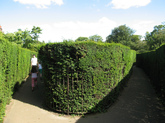Classic Elizabethan Hedge Maze

Erica's Original Notes
The Maze was opened on June 20, 1982. The McLean Foundation was a substantial donor. It was designed by Allan Brown, with the plan being painted on the ground, a quarter at a time. It contains 2,000 Thuja pyramidalis and has a diameter of 100 feet.
Although today the words 'maze' and 'labyrinth' are used interchangeably, strictly speaking a labyrinth is unicursal (without branches), and a maze, like the one in the Garden, is always multicursal (branches and dead ends). Mazes were used in Northern Europe and eventually came to be associated with those made with hedges. Labyrinth was the word used in Egypt and Crete and is associated with underground structures.
The first recorded maze in history was the Egyptian Labyrinth as noted by Herodotus, a Greek traveler and writer in the 5th century BC. The most famous labyrinth is contained in the legend of Theseus and the Minotaur. Theseus, son of King Aegeus of Athens, used a ball of wool given to him by Ariadne to mark his way through the labyrinth of the Minotaur at the Palace of Knossos in Crete (before 1500 BC). He slayed the monster and retraced his steps with the aid of the thread and so to safety.
Some labyrinths appear to be constructed with mathematical precision in connection with the movement of the sun. The shape of the 7-circuit labyrinth mirrors the motion of the planet Mercury in the sky over a long period of time. Did some ancient astronomer record this motion, and create the labyrinth symbol based upon it?
The purpose of mazes and labyrinths goes beyond entertainment and recreational to penitential. The early Christian church used the idea of mazes as a symbol of the path to heaven. As the Roman Empire fell and the Middle Ages (5th -15th centuries) arose, labyrinths started to appear as a feature in churches as Christianity spread across Europe. These church labyrinths were not three-dimensional but appeared as art painted on walls or inlaid on the floor. The purpose of these labyrinths is a matter of conjecture. Some authorities hold that they represent difficulties and intricacies that beset a Christian during his life. Another view is that they are a symbol of the entangling nature of sin. Some of the larger floor versions of these labyrinths may have been used as the path for miniature pilgrimages. Examples of mazes that were traversed on knees have been found on ancient stones and in churches. Sods of turf or stones delineated some religious mazes.
Hedge mazes evolved from the knot gardens of Renaissance Europe and were first constructed during the mid-16th century. They became an important component of Renaissance Gardens such as Hampton Court and were more for dallying with ladies than for botanical concern!
Versailles' extravagant garden of Louis XIV had a labyrinth with 39 groups of statues, while in our Garden we have a Monkey Puzzle tree in the centre!
In addition to the religious and recreational, mazes have been given other symbolic meanings. The maze may represent the journey of life, the search for the truth, the unknown, or a way of confounding evil spirits. The winding paths and alleys are endowed with great symbolic importance as a depiction of the struggles and challenges that we all face. The compilation of spirals symbolizes the cosmos, the way, the womb, beginnings and endings.
2013 Updates (LG): References to mazes and labyrinths in literature:
W.H. Auden’s poem The Labyrinth addresses the issue of perspective. Whatever one can say or know is only known from a chosen point of view. While a fellow is lost in the labyrinth he is trying to make sense of the world.
Nietzsche used the labyrinth as a frequent image to symbolize the unconscious self.
E.M. Forster in his short story The Other Side of the Hedge talks about transitioning from life on Earth to life in Heaven after the protagonist forces himself through the hedge.
Franz Kafka’s short story A Chinese Puzzle uses the little ball travelling back and forth in the maze to depict confusion as to our role in this world.
James Joyce in his novel A Portrait of the Artist as a Young Man uses the maze to symbolize entrapment.